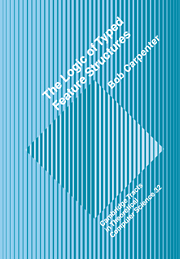 The Logic of Typed Feature Structures
The Logic of Typed Feature Structures Published online by Cambridge University Press: 12 October 2009
With our definition of inheritance, we have a notion of consistency and unification for our smallest conceptual unit, the type. We now turn to the task of developing structured representations that can be built out of the basic concepts, which we call feature structures. The reason for the qualifier is that even though feature structures are defined using our type symbols, they are not typed, in the sense that there is no restriction on the co-occurrence of features or restrictions on their values. We introduce methods for specifying appropriateness conditions on features and a notion of well-typing only after studying the ordered notion of feature structures. We also hold off on introducing inequations and extensionality conditions. Before introducing these other topics, we concentrate on fully developing the notion of untyped feature structure and the logical notions we employ. Most of the results that hold for feature structures can be immediately generalized to well-typed feature structures by application of the type inference mechanism.
Our feature structures are structurally similar to the more traditional form of feature structures such as those used in the patr-ii system and those defined by Rounds and Kasper. The next major development after these initial systems was introduced by Moshier (1988). The innovation of Moshier's system was to allow atomic symbols to label arbitrary nodes in a feature structure. He also treated the identity conditions for these atoms fully intensionally. Both patr-ii and the Rounds and Kasper systems treated feature structures intensionally, but enforced extensional identity conditions on atoms.
To save this book to your Kindle, first ensure [email protected] is added to your Approved Personal Document E-mail List under your Personal Document Settings on the Manage Your Content and Devices page of your Amazon account. Then enter the ‘name’ part of your Kindle email address below. Find out more about saving to your Kindle.
Note you can select to save to either the @free.kindle.com or @kindle.com variations. ‘@free.kindle.com’ emails are free but can only be saved to your device when it is connected to wi-fi. ‘@kindle.com’ emails can be delivered even when you are not connected to wi-fi, but note that service fees apply.
Find out more about the Kindle Personal Document Service.
To save content items to your account, please confirm that you agree to abide by our usage policies. If this is the first time you use this feature, you will be asked to authorise Cambridge Core to connect with your account. Find out more about saving content to Dropbox.
To save content items to your account, please confirm that you agree to abide by our usage policies. If this is the first time you use this feature, you will be asked to authorise Cambridge Core to connect with your account. Find out more about saving content to Google Drive.